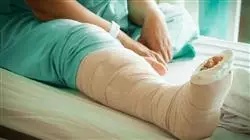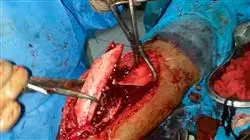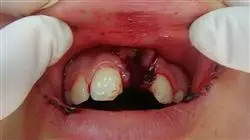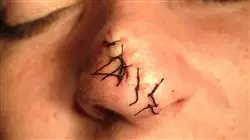University certificate
The world's largest faculty of medicine”
Introduction to the Program
Improve your knowledge in Trauma Emergencies through this program, where you will find the best teaching material with real clinical cases. Learn about the latest advances in the specialty to be able to provide excellent medical care"

The aim of this program is to bring together the experience accumulated over years of caring for this type of pathologies, which have allowed the authors to participate with enthusiasm, involvement and dedication in the development of a program designed to be highly practical, with a background based on the body of knowledge of one of the extensive and most exciting specialties of medicine.
The focus on time management and direct and early care of trauma patients, all within a holistic approach, are factors that make this program a unique learning experience and one that's in line with a context in which specific training determines a precise and safe approach to the patient, and not only to the particular pathology. In short, it insists on the need to provide personalized care, in an extraordinary effort, aimed at harmonizing art with science in the care of acute and urgent pathology in traumatology.
Update your knowledge through the Professional master’s degree in Trauma Emergencies"
This Professional master’s degree in Trauma Emergencies contains the most complete and up-to-date scientific program on the market. The most important features include:
- More than 75 clinical cases presented by experts in Trauma Emergencies
- The graphic, schematic, and practical contents with which they are created provide scientific and practical information on the disciplines that are essential for professional practice
- Latest diagnostic-therapeutic developments on assessment, diagnosis, and treatment in trauma emergencies
- Practical exercises where the self-evaluation process can be carried out to improve learning
- Clinical iconography and diagnostic imaging tests
- An algorithm-based interactive learning system for decision-making in the clinical situations presented throughout the course
- Special emphasis on evidence-based medicine and research methodologies in trauma emergencies
- All of this will be complemented by theoretical lessons, questions to the expert, debate forums on controversial topics, and individual reflection assignments
- Content that is accessible from any fixed or portable device with an Internet connection
This Professional master’s degree is the best investment you can make when selecting a refresher program, for two reasons: in addition to updating your knowledge in Trauma Emergencies, you will obtain a qualification from TECH Global University"
The teaching staff includes professionals from the field of Trauma Emergencies, who contribute their years of experience to this program, as well as renowned specialists from leading scientific societies.
The multimedia content developed with the latest educational technology will provide the professional with situated and contextual learning, i.e., a simulated environment that will provide an immersive academic experience programmed to learn in real situations.
This program is designed around Problem-Based Learning, whereby the physician must try to solve the different professional practice situations that arise throughout the program. For this purpose, the physician will be assisted by an innovative interactive video system created by renowned and experienced experts in the field of trauma emergencies with extensive teaching experience.
Increase your decision-making confidence by updating your knowledge through this Professional master’s degree"

Make the most of the opportunity to learn about the latest advances in Trauma Emergencies and improve your patient care"
Syllabus
The structure of the contents has been designed by a team of professionals from the best hospitals and universities, who are aware of the relevance of current education to intervene in the diagnosis and treatment of oncological neurological pathology, and who are committed to quality teaching through new educational technologies.

This Professional master’s degree in Trauma Emergencies contains the most complete and up-to-date scientific program on the market”
Module 1. Holistic Approach to the Patient in Trauma Emergencies
1.1. Differences Between Polytraumatized, Polyconcussed and Polyfractured
1.2. First Assessment
1.2.1. Airway Management
1.2.2. Breathing
1.2.3. Circulation
1.2.4. Neurological Deficit
1.2.5. Exhibition
1.3. Second Assessment
1.3.1. Complete Physical Examination
1.3.2. Position for Exploration and Controlled Mobilization
1.4. Initial Imaging Tests
1.4.1. X-Rays: Thorax, Pelvis, Cervical Spine
1.4.2. Computerized Tomography: Columna, Thorax, Abdomen, Pelvis
1.5. Intubation
1.5.1. Airway Management
1.5.2. Cervical Manipulation
1.5.3. Crico-Thyroidotomy
1.6. Ultrasound Scanning Protocol FAST Exam
1.7. Damage Control in Trauma Emergencies
1.8. Real Trauma Emergencies
1.8.1. Compartment Syndrome
1.8.2. Open Fracture
1.8.3. Septic Arthritis
1.8.4. Traumatic Arthrotomy
1.8.5. Necrotizing Fasciitis
1.8.6. Open Book Fracture with Hemodynamic Repercussion
1.9. What to Write, How to Write It and When to Write It
1.10. Most Frequent Errors when Preparing the Discharge Report
1.11. Desired Recommendations and Instructions
Module 2. Orthopedic Examination in the Emergency Department
2.1. Systematics
2.1.1. Inspection
2.1.2. Palpation
2.1.3. Mobilization
2.1.4. MRC Scale
2.1.5. Simple X-Rays
2.1.6. Complementary Tests
2.2. Segmental and Peripheral Neurological Examination in Trauma Emergencies
2.3. Spinal Column Examination
2.3.1. Inspection
2.3.1.1. Injuries
2.3.1.2. Skin Alterations
2.3.1.3. Muscular Atrophy
2.3.1.4. Bone Deformities
2.3.2. Gait Alteration
2.3.2.1. Unstable Gait with Wide Base (Myelopathy)
2.3.2.2. Foot Drop (Weakness of Tibialis Anterior or Extensor Longus of the First Toe, L4-L5 Root Compression)
2.3.2.3. Gastrocnemius-Soleus Weakness, S1-S2 Root Compression
2.3.2.4. Abductor Banding (Weakness of the Gluteus Medius due to Radicular Compression of L5)
2.3.3. Palpation
2.3.3.1. Anatomic References
2.3.3.2. Bone Palpation
2.3.3.3. Soft Tissues, Para-Vertebral Musculature
2.3.4. Range of Mobility
2.3.4.1. Cervical
2.3.4.2. Thoracic
2.3.4.3. Lumbar
2.3.5. Neurovascular
2.3.5.1. Strength
2.3.5.2. Sensory
2.3.5.3. Reflex
2.3.6. Additional Tests
2.3.6.1. Anal Tone
2.3.6.2. Bulbocavernous Reflex
2.3.6.3. Assessment Test of the Three Regions (Cervical, Dorsal, Lumbo-Sacral)
2.4. Shoulder Examination
2.4.1. Inspection
2.4.2. Palpation
2.4.3. Movement Arcs
2.4.4. Neurovascular
2.4.5. Specific Tests
2.5. Elbow Exploration
2.5.1. Inspection
2.5.2. Palpation
2.5.3. Movement Arcs
2.5.4. Neurovascular
2.5.5. Specific Tests
2.6. Wrist Examination
2.6.1. Inspection
2.6.2. Palpation
2.6.3. Movement Arcs
2.6.4. Neurovascular
2.6.5. Specific Tests
2.7. Hand Examination
2.7.1. Inspection
2.7.2. Palpation
2.7.3. Movement Arcs
2.7.4. Neurovascular
2.7.5. Specific Tests
2.8. Hip Examination
2.8.1. Inspection
2.8.2. Palpation
2.8.3. Movement Arcs
2.8.4. Neurovascular
2.8.5. Specific Tests
2.9. Knee Examination
2.9.1. Inspection
2.9.2. Palpation
2.9.3. Movement Arcs
2.9.4. Neurovascular
2.9.5. Specific Tests
2.10. Ankle and Foot Examination
2.10.1. Inspection
2.10.2. Palpation
2.10.3. Movement Arcs
2.10.4. Neurovascular
2.10.5. Specific Tests
Module 3. Trauma Emergencies of the Upper Limb
3.1. Shoulder and Arm
3.1.1. Gleno-Humeral Dislocation
3.1.1.1. Injury Biomechanics
3.1.1.2. Physical Examination
3.1.1.3. Diagnostic Imaging
3.1.1.4. Classification
3.1.1.5. Closed Treatment
3.1.1.6. Post-Reduction Management
3.1.2. Fracture of the Proximal Humerus
3.1.2.1. Injury Biomechanics
3.1.2.2. Physical Examination
3.1.2.3. Diagnostic Imaging
3.1.2.4. Classification
3.1.2.5. Therapeutic Strategy
3.1.2.6. Surgical Management
3.1.2.6.1. Non-Urgent with a Follow-Up in 1 Week
3.1.2.7. Orthopedic Management
3.1.3. Clavicle Fracture
3.1.3.1. Injury Biomechanics
3.1.3.2. Physical Examination
3.1.3.3. Diagnostic Imaging
3.1.3.4. Classification
3.1.3.5. Therapeutic Strategy
3.1.3.5.1. Orthopedic Management
3.1.3.5.2. Surgical Management
3.1.4. Acromio-Clavicular Injury
3.1.4.1. Injury Biomechanics
3.1.4.2. Physical Examination
3.1.4.3. Diagnostic Imaging
3.1.4.4. Rockwood Classification
3.1.4.5. Therapeutic Strategy
3.1.4.5.1. Orthopedic Management
3.1.4.5.2. Surgical Management
3.1.5. Sterno-Clavicular Injury
3.1.5.1. Injury Biomechanics
3.1.5.2. Physical Examination
3.1.5.3. Diagnostic Imaging
3.1.5.4. Classification
3.1.5.5. Treatment
3.1.6. Septic Arthritis of the Shoulder
3.1.6.1. Risk Factors
3.1.6.2. Physical Examination
3.1.6.3. Diagnostic Imaging
3.1.6.4. Arthrocentesis and Sampling
3.1.6.5. Therapeutic Plan
3.1.7. Scapula Fracture
3.1.7.1. Injury Biomechanics
3.1.7.2. Physical Examination
3.1.7.3. Diagnostic Imaging
3.1.7.4. Therapeutic Strategy
3.1.7.4.1. Orthopedic Management
3.1.7.4.2. Surgical Management
3.1.8. Fracture of the Body of the Humerus
3.1.8.1. Injury Biomechanics
3.1.8.2. Physical Examination
3.1.8.3. Diagnostic Imaging
3.1.8.4. Classification
3.1.8.5. Therapeutic Strategy
3.1.8.5.1. Orthopedic Management
3.1.8.5.2. Surgical Management
3.1.9. Fracture of the Distal Humerus
3.1.9.1. Injury Biomechanics
3.1.9.2. Physical Examination
3.1.9.3. Diagnostic Imaging
3.1.9.4. Classification
3.1.9.4.1. Descriptive
3.1.9.4.2. Milch Classification
3.1.9.4.3. Jupiter Classification
3.1.9.5. Therapeutic Strategy
3.1.9.5.1. Surgical Management
3.1.9.5.2. Orthopedic Management
3.1.10. Olecranon Fracture
3.1.10.1. Injury Biomechanics
3.1.10.2. Physical Examination
3.1.10.3. Diagnostic Imaging
3.1.10.4. Classification
3.1.10.5. Therapeutic Strategy
3.1.10.5.1. Orthopedic Management
3.1.10.5.2. Surgical Management
3.1.11. Radial Head Fracture
3.1.11.1. Injury Biomechanics
3.1.11.2. Physical Examination
3.1.11.3. Diagnostic Imaging
3.1.11.4. Mason Classification
3.1.11.4.1. Infiltration / Aspiration
3.1.11.5. Therapeutic Strategy
3.1.11.5.1. Orthopedic Management
3.1.11.5.2. Surgical Management
3.1.12. Elbow Dislocation
3.1.12.1. Injury Biomechanics
3.1.12.2. Physical Examination
3.1.12.3. Diagnostic Imaging
3.1.12.4. Classification
3.1.12.5. Initial Management
3.1.12.6. Orthopedic Management
3.1.12.7. Surgical Treatment
3.1.13. Coronoid Tubercle Fracture
3.1.13.1. Coronoid Osteology
3.1.13.2. Combined Injuries
3.1.13.3. Injury Biomechanics
3.1.13.4. Physical Examination
3.1.13.5. Diagnostic Imaging
3.1.13.6. Classification
3.1.13.7. Therapeutic Strategy
3.1.13.7.1. Orthopedic Management
3.1.13.7.2. Surgical Treatment
3.1.14. Fracture of the Capitellum
3.1.14.1. Injury Biomechanics
3.1.14.2. Physical Examination
3.1.14.3. Diagnostic Imaging
3.1.14.4. Classification
3.1.14.5. Therapeutic Strategy
3.1.14.5.1. Orthopedic Management
3.1.14.5.2. Surgical Treatment
3.1.15. Forearm Fracture (Radius and Ulna Diaphysis)
3.1.15.1. Injury Biomechanics
3.1.15.2. Physical Examination
3.1.15.3. Diagnostic Imaging
3.1.15.4. Therapeutic Strategy
3.1.15.4.1. Orthopedic Management
3.1.15.4.2. Surgical Treatment
3.2. Wrist and Hand (Except Fingers)
3.2.1. Fracture of the Distal Radius
3.2.1.1. Injury Biomechanics
3.2.1.2. Physical Examination
3.2.1.3. Diagnostic Imaging
3.2.1.4. Classification Systems
3.2.1.5. Therapeutic Strategy
3.2.2. Distal Radial-Ulnar Joint Injury
3.2.2.1. Injury Biomechanics
3.2.2.2. Physical Examination
3.2.2.3. Diagnostic Imaging
3.2.2.4. Therapeutic Strategy
3.2.2.4.1. Orthopedic Management
3.2.2.4.2. Surgical Treatment
3.2.3. Fracture of the Carpus (Without Scaphoid)
3.2.3.1. Injury Biomechanics
3.2.3.2. Physical Examination
3.2.3.3. Diagnostic Imaging
3.2.3.4. Pyramidal Fracture
3.2.3.4.1. Cortical Fracture (Avulsion)
3.2.3.4.2. Fracture of the Body
3.2.3.4.3. Avulsion Volar Fracture
3.2.3.5. Therapeutic Strategy
3.2.3.5.1. Orthopedic Management
3.2.3.5.2. Surgical Treatment
3.2.4. Trapezius Fracture
3.2.4.1. Classification
3.2.4.2. Therapeutic Strategy
3.2.4.2.1. Orthopedic Management
3.2.4.2.2. Surgical Treatment
3.2.5. Large Bone Fracture
3.2.5.1. Classification
3.2.5.2. Therapeutic Strategy
3.2.5.2.1. Orthopedic Management
3.2.5.2.2. Surgical Treatment
3.2.6. Scaphoid Fracture
3.2.6.1. Injury Biomechanics
3.2.6.2. Diagnostic Imaging
3.2.6.2.1. X-Rays
3.2.6.2.2. CAT Scan
3.2.6.2.3. Limitations
3.2.6.3. Classification Systems
3.2.6.4. Therapeutic Strategy
3.2.6.4.1. Orthopedic Management
3.2.6.4.2. Surgical Treatment
3.2.7. Hamate Fracture
3.2.7.1. Classification
3.2.7.2. Therapeutic Strategy
3.2.7.2.1. Orthopedic Management
3.2.7.2.2. Surgical Treatment
3.2.8. Pisiform Fracture
3.2.8.1. Classification
3.2.8.2. Therapeutic Strategy
3.2.8.2.1. Orthopedic Management
3.2.8.2.2. Surgical Treatment
3.2.9. Fracture of the Semilunar Bone
3.2.9.1. Classification
3.2.9.2. Therapeutic Strategy
3.2.9.2.1. Orthopedic Management
3.2.9.2.2. Surgical Treatment
3.2.10. Trapezoid Fracture
3.2.10.1. Classification
3.2.10.2. Therapeutic Strategy
3.2.10.2.1. Orthopedic Management
3.2.10.2.2. Surgical Treatment
3.2.11. Scapho-Lunar Instability
3.2.11.1. Injury Biomechanics
3.2.11.2. Diagnostic Imaging
3.2.11.3. Watson States in SLAC
3.2.11.4. Therapeutic Strategy
3.2.11.4.1. Orthopedic Management
3.2.11.4.2. Surgical Treatment
3.2.12. Dislocation of the Semilunar Bone
3.2.12.1. Injury Biomechanics
3.2.12.2. Diagnostic Imaging
3.2.12.3. Classification
3.2.12.4. Therapeutic Strategy
3.2.12.4.1. Orthopedic Management
3.2.12.4.2. Surgical Treatment
3.2.13. Tendon Injuries
3.2.14. Finger Fractures and Dislocations
3.2.15. Finger Amputation
3.2.16. Foreign Bodies in Wrist and Hand
3.2.17. Hand Infections
Module 4. Trauma Emergencies of the Pelvis and Lower Limbs
4.1. Acetabular Fractures
4.1.1. Injury Biomechanics
4.1.2. Diagnostic Imaging
4.1.3. Classification
4.2. Labral Injuries
4.2.1. Injury Biomechanics
4.2.2. Diagnostic Imaging
4.2.3. Classification
4.2.4. Therapeutic Strategy
4.2.4.1. Orthopedic Management
4.2.4.2. Surgical Treatment
4.3. Fracture of the Distal Femur
4.3.1. Injury Biomechanics
4.3.2. Diagnostic Imaging
4.3.3. Classification
4.3.4. Therapeutic Strategy
4.3.4.1. Orthopedic Management
4.3.4.2. Surgical Treatment
4.4. Femoral Diaphysis Fracture
4.4.1. Injury Biomechanics
4.4.2. Diagnostic Imaging
4.4.3. Classification
4.4.4. Therapeutic Strategy
4.4.4.1. Orthopedic Management
4.4.4.2. Surgical Treatment
4.5. Hip Dislocation
4.5.1. Injury Biomechanics
4.5.2. Diagnostic Imaging
4.5.3. Classification
4.5.4. Therapeutic Strategy
4.5.4.1. Orthopedic Management
4.5.4.2. Surgical Treatment
4.6. Hip Prosthesis Dislocation
4.6.1. Injury Biomechanics
4.6.2. Diagnostic Imaging
4.6.3. Classification
4.6.4. Therapeutic Strategy
4.6.4.1. Orthopedic Management
4.6.4.2. Surgical Treatment
4.7. Impending Fractures
4.7.1. Injury Biomechanics
4.7.2. Diagnostic Imaging
4.7.3. Classification
4.7.4. Therapeutic Strategy
4.8. Inter-Trochanteric and Sub-Trochanteric Fractures
4.8.1. Injury Biomechanics
4.8.2. Diagnostic Imaging
4.8.3. Classification
4.8.4. Therapeutic Strategy
4.8.4.1. Orthopedic Management
4.8.4.2. Surgical Treatment
4.9. Femoral Neck Fracture
4.9.1. Injury Biomechanics
4.9.2. Diagnostic Imaging
4.9.3. Classification
4.9.4. Therapeutic Strategy
4.9.4.1. Orthopedic Management
4.9.4.2. Surgical Treatment
4.10. Knee Dislocation
4.10.1. Injury Biomechanics
4.10.2. Diagnostic Imaging
4.10.3. Classification
4.10.4. Therapeutic Strategy
4.10.4.1. Orthopedic Management
4.10.4.2. Surgical Treatment
4.11. Meniscal Injuries
4.11.1. Injury Biomechanics
4.11.2. Diagnostic Imaging
4.11.3. Classification
4.11.4. Therapeutic Strategy
4.11.4.1. Orthopedic Management
4.11.4.2. Surgical Treatment
4.12. Quadriceps or Patellar Tendon Rupture
4.12.1. Injury Biomechanics
4.12.2. Diagnostic Imaging
4.12.3. Classification
4.12.4. Therapeutic Strategy
4.12.4.1. Orthopedic Management
4.12.4.2. Surgical Treatment
4.13. Patella Fractures
4.13.1. Injury Biomechanics
4.13.2. Diagnostic Imaging
4.13.3. Classification
4.13.4. Therapeutic Strategy
4.13.4.1. Orthopedic Management
4.13.4.2. Surgical Treatment
4.14. Patella Dislocation
4.14.1. Injury Biomechanics
4.14.2. Diagnostic Imaging
4.14.3. Classification
4.14.4. Therapeutic Strategy
4.14.4.1. Orthopedic Management
4.14.4.2. Surgical Treatment
4.15. Peri-Prosthetic Hip Fractures
4.15.1. Injury Biomechanics
4.15.2. Diagnostic Imaging
4.15.3. Classification
4.15.4. Therapeutic Strategy
4.15.4.1. Orthopedic Management
4.15.4.2. Surgical Treatment
4.16. Peri-Prosthetic Knee Fractures
4.16.1. Injury Biomechanics
4.16.2. Diagnostic Imaging
4.16.3. Classification
4.16.4. Therapeutic Strategy
4.16.4.1. Orthopedic Management
4.16.4.2. Surgical Treatment
4.17. Tibia and Fibula Diaphyseal Fractures
4.17.1. Injury Biomechanics
4.17.2. Diagnostic Imaging
4.17.3. Classification
4.17.4. Therapeutic Strategy
4.17.4.1. Orthopedic Management
4.17.4.2. Surgical Treatment
4.18. Pelvic Ring Injury
4.18.1. Injury Biomechanics
4.18.2. Diagnostic Imaging
4.18.3. Classification
4.18.4. Therapeutic Strategy
4.18.4.1. Orthopedic Management
4.18.4.2. Surgical Treatment
Module 5. Ankle and Foot Emergencies
5.1. Achilles Tendon Rupture
5.1.1. Injury Biomechanics
5.1.2. Diagnostic Imaging
5.1.3. Classification
5.1.4. Therapeutic Strategy
5.1.4.1. Orthopedic Management
5.1.4.2. Surgical Treatment
5.2. Ankle Fracture
5.2.1. Injury Biomechanics
5.2.2. Diagnostic Imaging
5.2.3. Classification
5.2.4. Therapeutic Strategy
5.2.4.1. Orthopedic Management
5.2.4.2. Surgical Treatment
5.3. Calcaneal Fracture
5.3.1. Injury Biomechanics
5.3.2. Diagnostic Imaging
5.3.3. Classification
5.3.4. Therapeutic Strategy
5.3.4.1. Orthopedic Management
5.3.4.2. Surgical Treatment
5.4. Proximal 5th Metatarsal Fracture
5.4.1. Injury Biomechanics
5.4.2. Diagnostic Imaging
5.4.3. Classification
5.4.4. Therapeutic Strategy
5.4.4.1. Orthopedic Management
5.4.4.2. Surgical Treatment
5.5. Lisfranc Injury
5.5.1. Injury Biomechanics
5.5.2. Diagnostic Imaging
5.5.3. Classification
5.5.4. Therapeutic Strategy
5.5.4.1. Orthopedic Management
5.5.4.2. Surgical Treatment
5.6. Metatarsal Fractures
5.6.1. Injury Biomechanics
5.6.2. Diagnostic Imaging
5.6.3. Classification
5.6.4. Therapeutic Strategy
5.6.4.1. Orthopedic Management
5.6.4.2. Surgical Treatment
5.7. Navicular Fracture
5.7.1. Injury Biomechanics
5.7.2. Diagnostic Imaging
5.7.3. Classification
5.7.4. Therapeutic Strategy
5.7.4.1. Orthopedic Management
5.7.4.2. Surgical Treatment
5.8. Tibial Pylon Fracture
5.8.1. Injury Biomechanics
5.8.2. Diagnostic Imaging
5.8.3. Classification
5.8.4. Therapeutic Strategy
5.8.4.1. Orthopedic Management
5.8.4.2. Surgical Treatment
5.9. Fracture of the Neck of the Talus
5.9.1. Injury Biomechanics
5.9.2. Diagnostic Imaging
5.9.3. Classification
5.9.4. Therapeutic Strategy
5.9.4.1. Orthopedic Management
5.9.4.2. Surgical Treatment
5.10. Fracture of the Lateral Process of the Talus
5.10.1. Injury Biomechanics
5.10.2. Diagnostic Imaging
5.10.3. Classification
5.10.4. Therapeutic Strategy
5.10.4.1. Orthopedic Management
5.10.4.2. Surgical Treatment
5.11. Fracture of the Phalanges of the Foot
5.11.1. Injury Biomechanics
5.11.2. Diagnostic Imaging
5.11.3. Classification
5.11.4. Therapeutic Strategy
5.11.4.1. Orthopedic Management
5.11.4.2. Surgical Treatment
Module 6. Trauma Emergencies in Children
6.1. Pediatric Patient Sedation
6.1.1. Anxiolysis, Analgesia, Sedation
6.1.2. Non-Pharmacological Agents
6.1.3. Local Blocks
6.1.4. Sedation
6.2. Immobilization in the Pediatric Patient
6.2.1. Challenges in the Placement of Immobilization Systems
6.2.1.1. Capacity for Understanding and Tolerance
6.2.1.2. Difficulties in Expressing Pain in the Child
6.2.1.3. Ages and Sizes
6.2.2. Recommendations During Immobilization
6.2.2.1. Types of Immobilization Systems
6.3. Principles of Immobilization
6.4. Signs of Child Abuse Non-Accidental Traumatic Injury (TNA)
6.4.1. Injury Biomechanics
6.4.1.1. Diagnostic Imaging
6.4.1.2. Classification
6.4.2. Typical or Common TNA Injuries
6.4.3. Orthopedic Management
6.4.4. Surgical Management
6.5. Salter-Harris Classification
6.5.1. Injury Biomechanics
6.5.2. Diagnostic Imaging
6.5.3. Classification
6.5.4. Therapeutic Strategy
6.5.4.1. Orthopedic Management
6.5.4.2. Surgical Treatment
6.6. Clavicle Fracture
6.6.1. Injury Biomechanics
6.6.2. Diagnostic Imaging
6.6.3. Classification
6.6.4. Therapeutic Strategy
6.6.4.1. Orthopedic Management
6.6.4.2. Surgical Treatment
6.7. Proximal Humerus Fracture
6.7.1. Injury Biomechanics
6.7.2. Diagnostic Imaging
6.7.3. Classification
6.7.4. Therapeutic Strategy
6.7.4.1. Orthopedic Management
6.7.4.2. Surgical Treatment
6.8. Humeral Diaphysis Fracture
6.8.1. Injury Biomechanics
6.8.2. Diagnostic Imaging
6.8.3. Classification
6.8.4. Therapeutic Strategy
6.8.4.1. Orthopedic Management
6.8.4.2. Surgical Treatment
6.9. Supracondylar Fracture of the Humerus
6.9.1. Injury Biomechanics
6.9.2. Diagnostic Imaging
6.9.3. Classification
6.9.4. Therapeutic Strategy
6.9.4.1. Orthopedic Management
6.9.4.2. Surgical Treatment
6.10. Humeral Condyle Fracture
6.10.1. Injury Biomechanics
6.10.2. Diagnostic Imaging
6.10.3. Classification
6.10.4. Therapeutic Strategy
6.10.4.1. Orthopedic Management
6.10.4.2. Surgical Treatment
6.11. Epicondyle Fracture
6.11.1. Injury Biomechanics
6.11.2. Diagnostic Imaging
6.11.3. Classification
6.11.4. Therapeutic Strategy
6.11.4.1. Orthopedic Management
6.11.4.2. Surgical Treatment
6.12. Distal Humeral Epiphysiolysis
6.12.1. Injury Biomechanics
6.12.2. Diagnostic Imaging
6.12.3. Classification
6.12.4. Therapeutic Strategy
6.12.4.1. Orthopedic Management
6.12.4.2. Surgical Treatment
6.13. Radial Head Subluxation (Painful Pronation)
6.13.1. Injury Biomechanics
6.13.2. Diagnostic Imaging
6.13.3. Classification
6.13.4. Therapeutic Strategy
6.13.4.1. Orthopedic Management
6.13.4.2. Surgical Treatment
6.14. Fracture of the Neck of the Radius
6.14.1. Injury Biomechanics
6.14.2. Diagnostic Imaging
6.14.3. Classification
6.14.4. Therapeutic Strategy
6.14.4.1. Orthopedic Management
6.14.4.2. Surgical Treatment
6.15. Ulna and Radius Fracture (Forearm)
6.15.1. Injury Biomechanics
6.15.2. Diagnostic Imaging
6.15.3. Classification
6.15.4. Therapeutic Strategy
6.15.4.1. Orthopedic Management
6.15.4.2. Surgical Treatment
6.16. Fracture of the Distal Radius
6.16.1. Injury Biomechanics
6.16.2. Diagnostic Imaging
6.16.3. Classification
6.16.4. Therapeutic Strategy
6.16.4.1. Orthopedic Management
6.16.4.2. Surgical Treatment
6.17. Monteggia Fracture
6.17.1. Injury Biomechanics
6.17.2. Diagnostic Imaging
6.17.3. Classification
6.17.4. Therapeutic Strategy
6.17.4.1. Orthopedic Management
6.17.4.2. Surgical Treatment
6.18. Galeazzi Fracture
6.18.1. Injury Biomechanics
6.18.2. Diagnostic Imaging
6.18.3. Classification
6.18.4. Therapeutic Strategy
6.18.4.1. Orthopedic Management
6.18.4.2. Surgical Treatment
6.19. Pelvis Fracture
6.19.1. Injury Biomechanics
6.19.2. Diagnostic Imaging
6.19.3. Classification
6.19.4. Therapeutic Strategy
6.19.4.1. Orthopedic Management
6.19.4.2. Surgical Treatment
6.20. Avulsion Pelvis Fractures
6.20.1. Injury Biomechanics
6.20.2. Diagnostic Imaging
6.20.3. Classification
6.20.4. Therapeutic Strategy
6.20.4.1. Orthopedic Management
6.20.4.2. Surgical Treatment
6.21. Coxalgia: Sepsis vs. Transient Synovitis
6.21.1. Interrogation
6.21.2. Physical Examination
6.21.3. Diagnostic Imaging
6.21.4. Complementary Tests
6.21.5. Kocher Criteria
6.21.6. Therapeutic Strategy
6.22. Hip Dislocation
6.22.1. Injury Biomechanics
6.22.2. Diagnostic Imaging
6.22.3. Classification
6.22.4. Therapeutic Strategy
6.22.4.1. Orthopedic Management
6.22.4.2. Surgical Treatment
6.23. Slipped Femoral Epiphysis
6.23.1. Interrogation
6.23.2. Physical Examination
6.23.3. Diagnostic Imaging
6.23.4. Classifications and Degrees of Severity
6.23.5. Therapeutic Strategy
6.23.5.1. Conservative Management
6.23.5.2. Surgical Indication
6.24. Hip Fracture
6.24.1. Interrogation
6.24.2. Physical Examination
6.24.3. Diagnostic Imaging
6.24.4. Classification
6.24.5. Therapeutic Strategy
6.24.5.1. Conservative Management
6.24.5.2. Surgical Indication
6.25. Femur Fracture
6.25.1. Injury Biomechanics
6.25.2. Diagnostic Imaging
6.25.3. Classification
6.25.4. Therapeutic Strategy
6.25.4.1. Orthopedic Management
6.25.4.2. Surgical Treatment
6.26. Epiphysiolysis of Distal Femur
6.26.1. Injury Biomechanics
6.26.2. Diagnostic Imaging
6.26.3. Classification
6.26.4. Therapeutic Strategy
6.26.4.1. Orthopedic Management
6.26.4.2. Surgical Treatment
6.27. Fracture of the Anterior Tibial Tuberosity
6.27.1. Injury Biomechanics
6.27.2. Diagnostic Imaging
6.27.3. Classification
6.27.4. Therapeutic Strategy
6.27.4.1. Orthopedic Management
6.27.4.2. Surgical Treatment
6.28. Tibial Tubercle Fracture (Gerdy)
6.28.1. Injury Biomechanics
6.28.2. Diagnostic Imaging
6.28.3. Classification
6.28.4. Therapeutic Strategy
6.28.4.1. Orthopedic Management
6.28.4.2. Surgical Treatment
6.29. Toddler Fracture
6.29.1. Injury Biomechanics
6.29.2. Diagnostic Imaging
6.29.3. Classification
6.29.4. Therapeutic Strategy
6.29.4.1. Orthopedic Management
6.29.4.2. Surgical Treatment
6.30. Ankle Fractures
6.30.1. Injury Biomechanics
6.30.2. Diagnostic Imaging
6.30.3. Classification
6.30.4. Therapeutic Strategy
6.30.4.1. Orthopedic Management
6.30.4.2. Surgical Treatment
Module 7. Trauma Spine Emergencies
7.1. Incomplete Spinal Cord Injury
7.1.1. Injury Biomechanics
7.1.2. Physical Examination
7.1.3. Diagnostic Imaging
7.1.4. Classification
7.1.4.1. Symptoms
7.1.4.2. ASIA Scale
7.1.5. Therapeutic Strategy
7.1.5.1. Initial Management
7.1.5.2. Surgical Treatment
7.2. Cauda Equina Syndrome
7.2.1. Interrogation
7.2.2. Physical Examination
7.2.3. Diagnostic Imaging
7.2.4. Treatment
7.3. Fracture in Patients with Ankylosing Spondylitis
7.3.1. Injury Biomechanics
7.3.2. Diagnostic Imaging
7.3.3. Classification
7.3.4. Therapeutic Strategy
7.3.4.1. Orthopedic Management
7.3.4.2. Surgical Treatment
7.4. Atlo-Axial Fractures
7.4.1. Injury Biomechanics
7.4.2. Diagnostic Imaging
7.4.3. Classification
7.4.4. Therapeutic Strategy
7.4.4.1. Conservative Management
7.4.4.2. Surgical Treatment
7.5. Odontoid Process Fracture
7.5.1. Injury Biomechanics
7.5.2. Physical Examination
7.5.3. Diagnostic Imaging
7.5.4. Classification
7.5.5. Therapeutic Strategy
7.5.5.1. Conservative Management
7.5.5.2. Surgical Treatment
7.6. Sub-Axial Fractures Between C3-C7
7.6.1. Injury Biomechanics
7.6.2. Physical Examination
7.6.3. Diagnostic Imaging
7.6.4. Classification
7.6.5. Therapeutic Strategy
7.6.5.1. Conservative Management
7.6.5.2. Surgical Treatment
7.7. Central Medullary Cord Syndrome
7.7.1. Injury Biomechanics
7.7.2. Physical Examination
7.7.3. Diagnostic Imaging
7.7.4. Classification
7.7.5. Therapeutic Strategy
7.7.5.1. Conservative Management
7.7.5.2. Surgical Treatment
7.8. Thoracic-Lumbar Fractures
7.8.1. Injury Biomechanics
7.8.2. Physical Examination
7.8.3. Diagnostic Imaging
7.8.4. Classification
7.8.5. Therapeutic Strategy
7.8.5.1. Conservative Management
7.8.5.2. Surgical Treatment
7.9. Fractures of Spinous Processes and Lateral Laminae
7.9.1. Injury Biomechanics
7.9.2. Physical Examination
7.9.3. Diagnostic Imaging
7.9.4. Classification
7.9.5. Therapeutic Strategy
7.9.5.1. Conservative Management
7.9.5.2. Surgical Treatment
7.10. Burst Fractures
7.10.1. Interrogation
7.10.2. Physical Examination
7.10.3. Diagnostic Imaging
7.10.4. Classification
7.10.5. Therapeutic Strategy
7.10.5.1. Conservative Management
7.10.5.2. Surgical Treatment
7.11. Chance Fractures
7.11.1. Injury Biomechanics
7.11.2. Physical Examination
7.11.3. Diagnostic Imaging
7.11.4. Classification
7.11.5. Therapeutic Strategy
7.11.5.1. Conservative Management
7.11.5.2. Surgical Treatment
7.12. Thoracic-Lumbar Fractures/Luxations
7.12.1. Injury Biomechanics
7.12.2. Physical Examination
7.12.3. Diagnostic Imaging
7.12.4. Classification
7.12.5. Therapeutic Strategy
7.12.5.1. Conservative Management
7.12.5.2. Surgical Treatment
7.13. Sacral Fractures
7.13.1. Injury Biomechanics
7.13.2. Physical Examination
7.13.3. Diagnostic Imaging
7.13.4. Classification
7.13.5. Therapeutic Strategy
7.13.5.1. Conservative Management
7.13.5.2. Surgical Treatment
7.14. Vertebral Osteomyelitis
7.14.1. Injury Biomechanics
7.14.2. Physical Examination
7.14.3. Diagnostic Imaging
7.14.4. Classification
7.14.5. Therapeutic Strategy
7.14.5.1. Conservative Management
7.14.5.2. Surgical Treatment
Module 8. Musculoskeletal Ultrasound and Radiological Studies in Trauma Emergencies
8.1. General Information on Musculoskeletal Ultrasonography
8.2. Indications on Musculoskeletal Ultrasonography
8.3. Ultrasound Support for Invasive Techniques
8.4. Indications for Simple X-Rays
8.5. Interpretation of Bone X-Rays
8.6. Radiological Characteristics of Fractures
8.7. Higher Resolution Imaging Studies Indicated in the Emergency Department (CT)

A unique, key and decisive educational experience to boost your professional development"
Professional Master's Degree in Trauma Emergencies
In order to provide quality care in the emergency service, it is of vital importance to have specialized skills in the medical management of various types of circumstances. For this reason, TECH Global University has created this program, with which professionals in the field will be able to delve into the tools, methods and techniques, such as radiological studies and musculoskeletal ultrasounds, necessary to carry out orthopedic explorations of the upper limbs, lower limbs, pelvis, spine, ankle and foot. All this, starting from the holistic approach to the patient, whose foundation enriches the daily clinical practice, as it favors each of the processes that make up the assessment: early identification, intervention of injuries, fractures and wounds and the prescription of comprehensive care during the rehabilitation period. Thanks to the proposed theoretical-practical path, it will be possible to establish an order, a method and a system of approach that will speed up the development of the semiological pictures of the pathologies.
Postgraduate program in Trauma Emergencies
Studying this TECH postgraduate program empowers students to implement medical action frameworks that will allow them to individualize and personalize the care offered to patients. Through the methodology of case analysis and problem-based learning, students will face real situations, where they will have to mobilize the resources available to adequately treat complications. This academic space will help them to develop both in the ways to treat the acute stages of pathologies and in the prevention of injury recurrence. The mastery of anatomical knowledge and the application of therapeutic techniques (invasive or non-invasive, immobilization, conservative management and surgical intervention) will serve as a basis for the graduate of the Professional Master's Degree in Trauma Emergencies to continue their specialization process, continuously improving their skills and outlining his analytical-interpretative abilities. In a second stage, this will characterize them as a seasoned and competent professional, whose excellence will be indispensable for the proper functioning of the emergency units of the different hospital centers.







